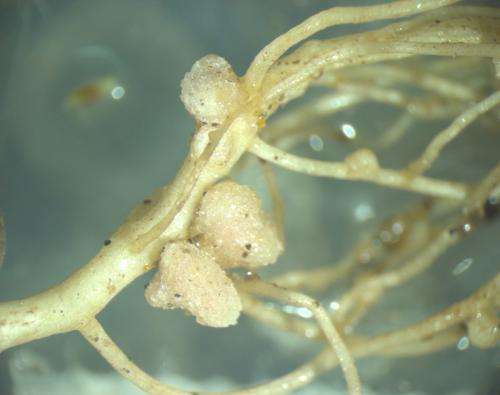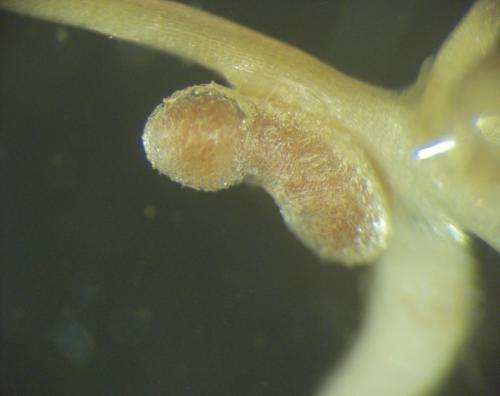Ancient evolutionary innovation enabled cooperation between plants and nitrogen-fixing bacteria

Bees pollinate plants in return for nectar, ants protect trees in return for housing, even our own bodies house microbial partners that help us digest our food. These types of beneficial relationships, called mutualisms, are at the heart of the world's biodiversity. Now an international team of scientists, led by VU University researchers, has published in Nature Communications how to reconstruct the ancient history of these partnerships and pinpoint the major events leading to the emergence of such ancient collaborations. This research has been financed by an NWO Vidi grant.
Reporting in the journal Nature Communications, the authors reveal the key evolutionary steps towards the emergence of a mutualism that transformed global nutrient cycles: the partnership between plants and their symbiotic nitrogen-fixing root bacteria.
Plants need nitrogen to survive. The atmosphere is made up of nitrogen gas but it is impossible for plants to extract the gas from the air without help. They are, however, good at producing sugar. Enter the symbiotic partnership: plants house and feed the bacteria (mostly called rhizobia) in their roots; in return the bacteria give their host plants nitrogen extracted from the air.
Symbiosis not in all plants
But, not all plants can form partnerships with rhizobia. Why not? By creating the first complete evolutionary reconstruction of this symbiosis, the researchers hoped to answer this question. VU PhD-student Gijsbert Werner, first author of the study, explains: 'There are enormous potential benefits of housing a nitrogen-producing factory in your roots, so it has always been a puzzle why this symbiosis is not more common. Now we finally have the tools to ask why.'

An ancient innovation enabled the symbiosis
The VU-researchers constructed the world's largest database of global Nitrogen-fixing plant species and used a newly developed mathematical model to reconstruct the 'deep' history of the nitrogen-fixing symbiosis. VU-Professor of Mutualistic Interactions and last author Toby Kiers elaborates: 'It was similar to looking for a needle in a haystack, but using this new technique and a huge dataset we pinpointed a single innovation evolving in plants over 100 million years ago that made symbiotic nitrogen-fixation possible. This finding confirmed a previous hypothesis made verbally almost twenty years ago.' 'After this innovation, symbiotic nitrogen-fixation became possible, evolving repeatedly in descendant plant species', VU co-author William Cornwell adds.
Tracking evolutionary histories of complex traits
The researchers were able to reveal more details of the complicated evolutionary history of symbiotic nitrogen fixation. For instance, they found that in some plant groups the interaction is extraordinarily stable, while in others it is easily lost. They also found that plants without the ancient innovation never form the symbiosis, explaining why it is not more commonly found. 'With reconstructions like these, we can literally look back hundreds of millions of years, and identify when and where crucial steps in the evolution of complex traits happened', Gijsbert Werner adds.
The world's most important symbiosis
These discoveries are important because this symbiosis is crucial for the nitrogen supply of many ecosystems and farming systems, making it one of our planet's most important symbioses. William Cornwell: 'The evolution of symbiotic nitrogen-fixing in plants transformed global nitrogen cycles: without this event our world would have looked very different.'
Creating sustainable symbiotic crops?
A long-standing goal in agriculture is the introduction of the nitrogen fixing partnership into non-fixing crops, like maize and wheat. The newly published research is a key step in determining if and how such symbiotic partnerships can be transferred. The researchers found that none of the major cereal grains are among the species 'primed' for the symbiosis, so modifying them for symbiosis will probably be difficult until the specific molecular machinery allowing for this priming is described. The researchers will now use the evolutionary reconstruction to understand the underlying genetics of the symbiosis. 'The history is only the first step: the million dollar-question is identifying what this innovation actually is', Toby Kiers says. 'If we solve that puzzle, we are getting closer to the goal of transferring the symbiosis, but I remain skeptical. The beauty of the symbiosis is its complexity, it is never easy to force partners to cooperate.'
Journal information: Nature Communications




















